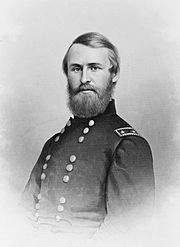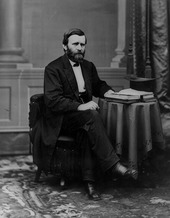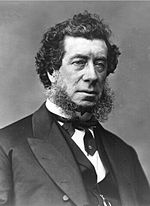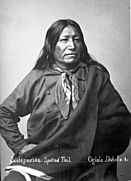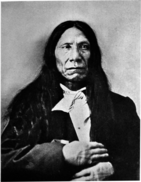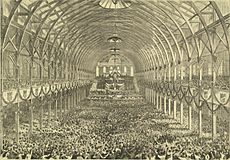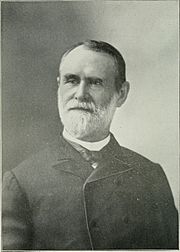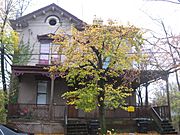Jacob Dolson Cox facts for kids
Quick facts for kids
Jacob Dolson Cox
|
|
|---|---|
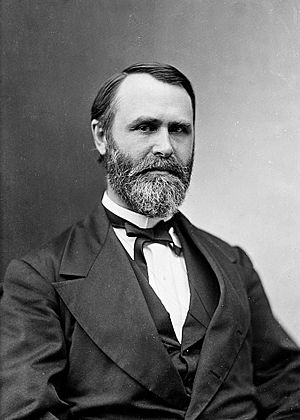 |
|
| Member of the U.S. House of Representatives from Ohio's 6th district |
|
| In office March 4, 1877 – March 3, 1879 |
|
| Preceded by | Frank H. Hurd |
| Succeeded by | William D. Hill |
| 15th President of the University of Cincinnati | |
| In office 1885–1889 |
|
| 10th United States Secretary of the Interior | |
| In office March 5, 1869 – October 31, 1870 |
|
| President | Ulysses S. Grant |
| Preceded by | Orville Hickman Browning |
| Succeeded by | Columbus Delano |
| 28th Governor of Ohio | |
| In office January 8, 1866 – January 13, 1868 |
|
| Lieutenant | Andrew McBurney |
| Preceded by | Charles Anderson |
| Succeeded by | Rutherford B. Hayes |
| Member of the Ohio Senate from the 23rd district |
|
| In office January 2, 1860 – January 5, 1862 |
|
| Preceded by | Robert Walker Tayler Sr. |
| Succeeded by | Samuel Quinby |
| Personal details | |
| Born | October 27, 1828 Montreal, Lower Canada (now Quebec) |
| Died | August 4, 1900 (aged 71) Gloucester, Massachusetts, U.S. |
| Political party | Republican |
| Spouse | Helen Finney |
| Education | Oberlin College (BA, MA) |
| Signature |  |
| Military service | |
| Allegiance | |
| Branch/service | United States Army • Union Army |
| Years of service | 1861–1866 |
| Rank | |
| Commands | Kanawha Division XXIII Corps |
| Battles/wars | American Civil War • Battle of South Mountain • Battle of Antietam • Atlanta Campaign • Battle of Utoy Creek • Battle of Franklin • Battle of Nashville • Battle of Wilmington • Battle of Wyse Fork |
Jacob Dolson Cox (born October 27, 1828 – died August 4, 1900) was an important American figure. He was a lawyer, a general in the Union Army during the American Civil War, and a Republican politician from Ohio. He also helped start the Liberal Republican Party.
Cox was an educator and author. He even studied microbes. He served as president of the University of Cincinnati. He was the 28th Governor of Ohio and the United States Secretary of the Interior.
As Governor of Ohio, Cox supported President Andrew Johnson's plan for Reconstruction after the Civil War. He did not support voting rights for African Americans in the South at first, but he did support it in Ohio. He chose not to run for governor again.
Later, President Ulysses S. Grant asked Cox to be his Secretary of the Interior. Cox accepted right away. As Secretary, Cox started the first civil service reform in a government department. This meant that people had to pass tests to get government jobs. President Grant supported this at first. But other politicians did not like it because they wanted to give jobs to their friends. Cox resigned because he couldn't get Grant's full support for these reforms.
In 1871, Cox helped create the Liberal Republican Party. This party was against Grant's re-election. In 1876, Cox became a U.S. Congressman from Ohio for one term. He tried to make civil service reform permanent, but it didn't happen during his term. Cox was also elected to the American Philosophical Society in 1870. He wrote several respected books about the Civil War.
Contents
Early Life and School
Jacob Dolson Cox was born in Montreal, which was then part of Canada, on October 27, 1828. His parents were Americans from New York. His father was a building contractor. When Jacob was one, his family moved back to New York City.
As a young man, Cox wanted to become a lawyer. But his family lost money during a financial crisis in 1837. This meant he couldn't afford college. He worked as an apprentice in a law firm for two years. Then he changed his mind and worked as a bookkeeper. In his free time, he studied math and old languages.
In 1846, he went to Oberlin College. It was a special college because it allowed both men and women, and students of different races. He studied to become a minister and graduated around 1850. After some disagreements about religion, Cox became the superintendent of schools in Warren, Ohio. He continued to study law and became a lawyer in 1853.
Family Life
While at Oberlin College, Cox married Helen Clarissa Finney in 1849. She was the daughter of the college president. Helen was a widow with a young son. Cox and his father-in-law had different ideas about religion. Cox and Helen had eight children together. Their son, Kenyon Cox, became a famous painter.
Politics and Military Service
Cox was a member of the Whig party, which was against slavery. When the Whig party ended, Cox helped start the Republican Party in Ohio in 1855. In 1859, he was elected to the Ohio State Senate. There, he became friends with James A. Garfield, who later became president.
While in the Senate, Cox joined the Ohio Militia as a brigadier general. He spent the winter of 1860–61 studying military science.
The Civil War Years
When the American Civil War began in 1861, Cox had six children. But he decided to join the Union Army. He was appointed Brigadier General of Ohio Volunteers.
His first job was to command a training camp. Then he led the Kanawha Brigade. His troops fought well in early battles. In 1862, his brigade became part of the IX Corps.
During the Maryland Campaign, Cox's men captured the city of Frederick, Maryland. He led the attack at the Battle of South Mountain on September 14, 1862. When his commander was killed, Cox took charge of the IX Corps. At the Battle of Antietam, Cox's troops almost broke through the Confederate lines. But they were pushed back by Confederate General A.P. Hill.
After Antietam, Cox was promoted to major general. He spent most of 1863 commanding military districts in Ohio and Michigan.
In 1864–65, during the Atlanta, Franklin-Nashville, and Carolinas campaigns, Cox led the 3rd Division of the XXIII Corps. His division played a key role in the Battle of Utoy Creek. Cox's men also cut off Confederate supply lines, which made General John Bell Hood leave Atlanta. Cox helped save the Union line at the Battle of Franklin in November 1864. He also led troops at the Battle of Wilmington and the Battle of Wyse Fork in North Carolina.
Ohio's Governor
Before leaving the Army in 1866, Cox was elected governor of Ohio in October 1865. He served from 1866 to 1868. He had moderate views on voting rights for African Americans. He also supported President Andrew Johnson's plans for Reconstruction. Because of these views, he decided not to run for governor again. After his term, he moved to Cincinnati to practice law.
Secretary of the Interior (1869–1870)
President Ulysses S. Grant appointed Cox as Secretary of the Interior in March 1869. Cox served for about a year and a half.
Starting Civil Service Reform
The Interior Department grew very large after the Mexican–American War. It handled patents, land, pensions, and Native American affairs. Many people believed that government jobs were given out based on favors, not skill. This was called the "spoils system."
Secretary Cox was a strong supporter of civil service reform. He was the first federal department head to start a merit system. This meant people had to prove they were qualified for jobs. Cox fired many clerks who were not qualified. He also started requiring tests for most job applicants. Many workers quit rather than take the tests. Cox even refused to give his own brother a job to avoid showing favoritism.
Cox's reforms caused problems with politicians who relied on the spoils system. These politicians wanted government workers to donate to their campaigns. Cox said that donations should be voluntary, but passing the civil service tests would be required.
A big disagreement happened over vacation time. Cox set a policy of 30 paid days off. Many workers complained to party leaders that they couldn't campaign enough. President Grant eventually overturned Cox's vacation rule.
Dominican Republic Annexation Plan
Before Grant became president, some American politicians wanted to take control of islands in the Caribbean. Secretary of State William H. Seward had tried to buy the Danish West Indies. These talks continued under President Grant, who was interested in buying the Dominican Republic. Grant believed it would help with race relations and increase American naval power.
Grant sent a trusted aide, Orville E. Babcock, to the Dominican Republic. Babcock came back with a draft treaty to buy the country. Secretary of State Hamilton Fish told Cox that Babcock had no authority to make such a treaty.
When Grant presented the treaty to his cabinet, everyone was quiet until Cox spoke up. He asked Grant if they really wanted to annex the Dominican Republic. Grant was embarrassed and changed the subject. The Senate later refused to pass the treaty.
Native American Affairs
After a difficult situation involving the Piegan Native Americans in January 1870, Secretary Cox asked Congress to create clear and lasting laws for Native American policy. President Grant wanted Native Americans to become "civilized." He had created the Board of Indian Commissioners in 1869.
Cox believed that new developments like railroads should not be an excuse to break treaties with Native Americans. He felt that keeping promises was important for peace.
In 1870, Sioux leaders Chief Red Cloud and Chief Spotted Tail were upset because white settlers were moving onto their land in Wyoming. To avoid war, they traveled to Washington, D.C., to meet with President Grant.
Cox was excited for their visit. He hoped to show them the government's power and commitment to treaties. On June 1, the chiefs toured Washington. On June 2, Spotted Tail criticized Cox for not keeping the Treaty of 1868. Cox told him that the Grant administration's policies were good.
On June 3, Red Cloud also complained about broken treaties and how his people were starving. Cox told them they would speak with President Grant. On June 7, Cox tried to calm the chiefs, saying President Grant wanted to do the right thing. Grant met with the chiefs and promised to keep the treaties. He even hosted a formal dinner for them at the White House.
At their last meeting, Cox offered more help. He promised to give the chiefs seventeen horses. Red Cloud apologized to Cox for his rudeness. Cox promised to help Native American interests. The aid package helped calm the situation and avoided war.
Resignation
In August 1870, Cox disagreed with President Grant over some land claims in California. Cox believed these claims were dishonest. He told Grant he wanted nothing to do with them. Cox felt that the Interior Department had the final say on the matter, not a court. When Grant didn't fully support Cox, Cox saw it as another reason to leave his job. His main reason for resigning was the lack of support for civil service reform.
Liberal Republican Movement (1870-1872)
Many people were unhappy with President Grant's administration. They disliked his appointments of family and friends and believed there was corruption. In 1870, Senator Carl Schurz left the Republican Party. After Cox resigned, many reformers felt Grant wasn't serious about civil service reform.
In March 1871, Cox helped organize a group of reforming Republicans in Cincinnati. They called themselves Liberal Republicans. This new party wanted civil service reform, honest money, and states' rights.
In May 1872, the Liberal Republicans held a convention in Cincinnati. They nominated Horace Greeley for President. Cox was considered for president but was not chosen. Cox did not support Greeley's nomination and withdrew his support from the Liberal Republican movement. Grant easily won re-election over Greeley.
Later Years
Railroad President (1873-1878)
In 1873, Cox became President of the Toledo and Wabash Railroad. He moved to Toledo, Ohio, and managed the railroad until 1878.
U.S. Representative (1877-1879)
Cox was elected to the United States House of Representatives from Ohio in 1876. He served one term from 1877 to 1879. He chose not to run for a second term.
Cincinnati Law School Dean (1881-1897)
After leaving Congress, Cox returned to Cincinnati. He became the Dean of the Cincinnati Law School from 1881 to 1897. After retiring, President William McKinley asked him to be the U.S. ambassador to Spain, but Cox declined.
University of Cincinnati President (1885-1889)
Cox also served as President of the University of Cincinnati from 1885 to 1889.
Military Historian and Author
In his later years, Cox wrote many books. His works include Atlanta (1882) and The March to the Sea: Franklin and Nashville (1882). He also wrote Military Reminiscences of the Civil War (1900). His books are still considered important and objective histories of the Civil War.
Death and Burial
Jacob Dolson Cox died on August 4, 1900, while on vacation in Gloucester, Massachusetts. He is buried in Spring Grove Cemetery in Cincinnati, Ohio.
Historical View
For most of the 20th century, historians didn't focus much on Jacob Dolson Cox. However, in the 21st century, there has been new interest in his military career during the Civil War. People are also interested in his work as Secretary of the Interior, where he started civil service reform. He was the first cabinet officer in U.S. history to do so.
Historians describe Cox as a fascinating person who achieved many things. He was seen as an effective Secretary of the Interior. His support for civil service reform went against powerful politicians. Historian Eugene D. Schmiel noted that Cox's work as Secretary of Interior led to "one of the most far-reaching attempts to reform Indian Policy." Cox's military writings are praised for being clear and fair.
Cox's home in Cincinnati, built in 1880, is listed on the National Register of Historic Places.
Microscopy Studies
Around 1873, Cox became interested in microscopy as a hobby. He studied tiny things like rotifers and diatoms in fresh water. He was very careful and logical in his studies, keeping detailed notes.
In 1874, he started taking photo-micrographs (photos through a microscope). He made hundreds of these photos of diatoms. In 1881, he was elected a fellow of the Royal Microscopical Society. Cox stopped his microscopy studies in 1895 because he believed it was hurting his eyes. But his interest in the subject lasted his whole life.


